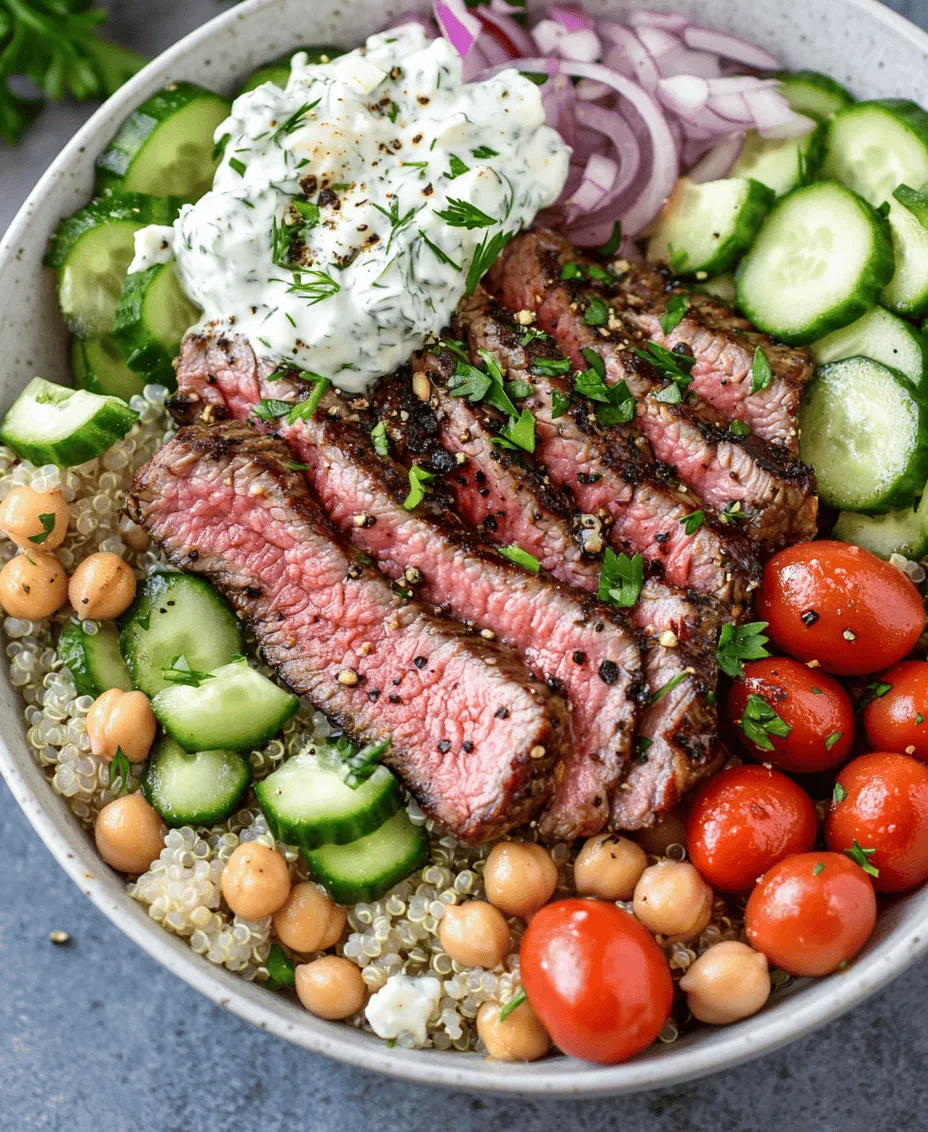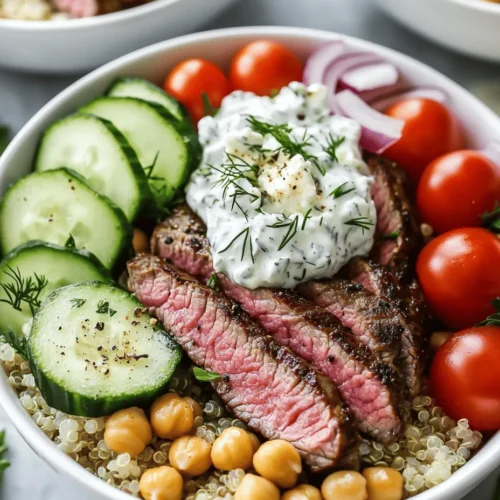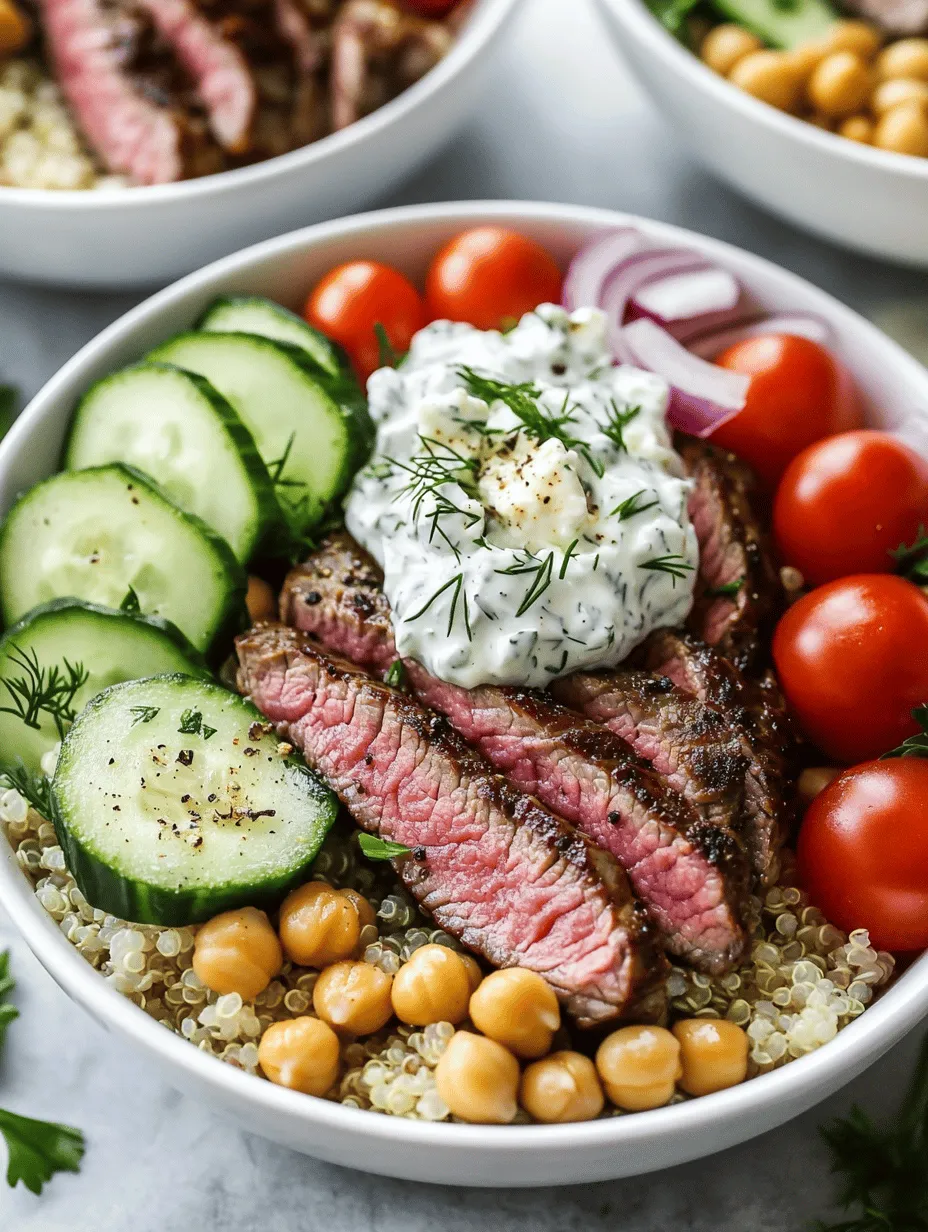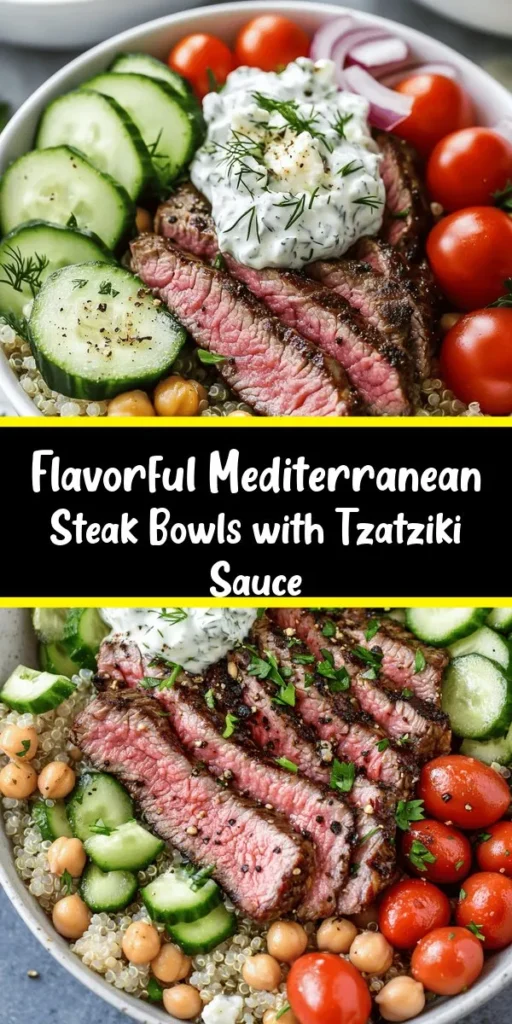Introduction
Mediterranean cuisine has long been celebrated for its vibrant flavors, fresh ingredients, and health benefits. With a focus on wholesome, nutrient-rich foods, it emphasizes the use of fresh fruits, vegetables, whole grains, legumes, and healthy fats, particularly olive oil. This culinary tradition has not only tantalized taste buds across the globe but has also been linked to various health advantages, such as improved heart health, weight management, and enhanced longevity.
Among the myriad of dishes that embody the essence of Mediterranean cooking, the Mediterranean Steak Bowl stands out as a wholesome and delicious option. This dish combines tender, marinated steak with a colorful array of fresh vegetables, grains, and a tangy tzatziki sauce, creating a meal that is as nutritious as it is flavorful. Each ingredient plays a crucial role in delivering the robust Mediterranean flavors that make this bowl not just a meal, but a culinary experience.
In Mediterranean cooking, the importance of fresh ingredients cannot be overstated. The vibrant colors and varied textures of the components contribute to not only the visual appeal but also the depth of flavor that characterizes this cuisine. The Mediterranean Steak Bowl encapsulates these principles perfectly, offering a balanced combination of protein, healthy carbs, and fresh produce that will leave you feeling satisfied and nourished.
Understanding the Ingredients
To create the perfect Mediterranean Steak Bowl, understanding the ingredients is essential. The principal components of this dish include flank steak or sirloin, olive oil, a selection of spices, fresh vegetables, feta cheese, a base of quinoa or couscous, and tzatziki sauce. Let’s delve into each of these ingredients and explore their nutritional benefits and flavor profiles.
Flank Steak or Sirloin
Flank steak or sirloin serves as the star protein in the Mediterranean Steak Bowl. Both cuts of beef are known for their rich flavor and tenderness when cooked correctly. Flank steak is particularly lean and packed with protein, making it an excellent choice for those looking to maintain a healthy diet while enjoying a hearty meal. Sirloin, while slightly fattier, offers a robust flavor and is also a great source of essential nutrients, including iron, zinc, and B vitamins, which are vital for energy production and overall well-being.
Olive Oil
Olive oil is a cornerstone of Mediterranean cooking, revered for its health benefits and versatility. Rich in monounsaturated fats, particularly oleic acid, olive oil can help reduce inflammation and lower the risk of chronic diseases. It is also packed with antioxidants, which contribute to its health-promoting properties. In the context of the Mediterranean Steak Bowl, olive oil is utilized not only for marinating the steak but also for drizzling over the finished dish, enhancing the overall flavor and health profile.
Spices
Spices play a pivotal role in Mediterranean cuisine, elevating dishes with their aromatic profiles. For the Mediterranean Steak Bowl, smoked paprika and garlic powder are essential. Smoked paprika adds a depth of flavor with its subtle smokiness, which complements the meat beautifully. Garlic powder lends a savory note that enhances the overall taste of the dish. Together, these spices create a robust flavor that embodies the essence of Mediterranean cooking.
Fresh Vegetables
Fresh vegetables are a defining characteristic of Mediterranean cuisine, contributing both nutrition and flavor. In our Mediterranean Steak Bowl, we include cherry tomatoes, cucumber, red onion, and chickpeas.
– Cherry Tomatoes: Bursting with sweetness and vibrant color, cherry tomatoes are a rich source of vitamins A and C, as well as antioxidants like lycopene, which is known for its heart-health benefits.
– Cucumber: Refreshing and hydrating, cucumber adds a crisp texture to the bowl. It’s low in calories while offering essential nutrients, including vitamin K.
– Red Onion: With its sharp flavor and beautiful color, red onion not only enhances the visual appeal of the dish but also provides antioxidants and vitamins that support overall health.
– Chickpeas: As a plant-based protein source, chickpeas are packed with fiber, which aids in digestion and helps keep you feeling full longer. They also add a nutty flavor and creamy texture to the bowl.
Feta Cheese
Feta cheese is a staple in many Mediterranean dishes, known for its crumbly texture and tangy flavor. Made from sheep’s or goat’s milk, feta is lower in fat than many other cheeses and offers a good source of calcium and protein. Its unique taste complements the other ingredients in the Mediterranean Steak Bowl, adding a creamy element that balances the dish.
Quinoa and Couscous
The base of our Mediterranean Steak Bowl can be either quinoa or couscous, both of which provide a nutritious foundation.
– Quinoa: A complete protein, quinoa contains all nine essential amino acids, making it an excellent choice for those following a plant-based diet. It’s also rich in fiber, vitamins, and minerals, contributing to the dish’s overall health benefits.
– Couscous: While technically a pasta, couscous is often treated like a grain and provides a light, fluffy texture that complements the steak and vegetables. It’s quick to prepare and pairs well with the flavors of the Mediterranean.
Tzatziki Sauce
No Mediterranean meal is complete without tzatziki sauce, a refreshing yogurt-based condiment that adds a creamy, tangy element to the dish. Originating from Greece, tzatziki is made with Greek yogurt, cucumber, garlic, and herbs like dill or mint. The yogurt provides a rich source of protein and probiotics, which are beneficial for gut health. The freshness of the cucumber and the aromatic herbs elevate the sauce, making it a perfect accompaniment to the Mediterranean Steak Bowl.
Marinating the Steak
Marinating the steak is a crucial step in developing the rich flavors that will define your Mediterranean Steak Bowl. A good marinade not only infuses the meat with flavor but also helps to tenderize it, ensuring that every bite is juicy and delicious.
Importance of Marination
The marination process allows the flavors from the ingredients to penetrate the meat, enhancing its natural taste. A well-marinated steak will have a depth of flavor that elevates the entire dish, making it more satisfying and enjoyable. Additionally, marinating can help to retain moisture during cooking, resulting in a tender steak that is not dry or tough.
Step-by-Step Guide to Marinating Steak
1. Choose Your Marinade Ingredients: For a Mediterranean twist, combine olive oil, smoked paprika, garlic powder, salt, pepper, and fresh herbs like oregano or thyme in a bowl.
2. Prepare the Steak: Place your flank steak or sirloin in a resealable plastic bag or a shallow dish.
3. Add the Marinade: Pour the marinade over the steak, ensuring that it is evenly coated. If using a bag, seal it tightly and massage the marinade into the meat.
4. Marinate: Allow the steak to marinate in the refrigerator for at least 30 minutes. For deeper flavor, aim for a marination time of 2-4 hours, or even overnight if time allows.
5. Remove and Rest: Once marinated, remove the steak from the fridge and let it sit at room temperature for about 15-20 minutes before cooking. This helps to ensure even cooking.
Suggested Marination Times and Tips
For optimal flavor absorption, marinating the steak for at least 2 hours is recommended. However, if you’re short on time, even a 30-minute marination can make a difference. If you have the luxury of time, letting the steak marinate overnight will yield the most flavorful results.
Feel free to experiment with the marinade ingredients to create your unique flavor profile. Consider adding ingredients like balsamic vinegar for tanginess, honey for sweetness, or even a splash of citrus juice for brightness. The possibilities are endless, allowing you to personalize your Mediterranean Steak Bowl to your taste.
Preparing the Tzatziki Sauce
Now that your steak is marinating, it’s time to prepare the tzatziki sauce, which will bring a refreshing contrast to the rich flavors of the beef.
Overview of Tzatziki Sauce
Tzatziki sauce is a beloved condiment in Mediterranean cuisine, known for its cool, creamy texture and zesty flavor. Traditionally served as a dip or accompaniment to grilled meats and vegetables, tzatziki enhances the overall dining experience by adding a refreshing element that balances the richness of the main dish.
Step-by-Step Instructions for Making Tzatziki
1. Gather Your Ingredients: You will need Greek yogurt, a cucumber, garlic, olive oil, lemon juice, salt, and fresh herbs (dill or mint).
2. Prepare the Cucumber: Grate or finely chop the cucumber. If using a grater, place the grated cucumber in a clean kitchen towel and squeeze out excess moisture to prevent the sauce from becoming watery.
3. Mix the Ingredients: In a bowl, combine the Greek yogurt, grated cucumber, minced garlic, olive oil, lemon juice, and a pinch of salt. Stir until well combined.
4. Add Fresh Herbs: Finely chop your choice of fresh herbs and mix them into the tzatziki for an extra layer of flavor.
5. Chill: For the best flavor, let the tzatziki sauce chill in the refrigerator for at least 30 minutes before serving. This allows the flavors to meld beautifully.
Importance of Using Greek Yogurt
Using Greek yogurt is key to achieving the desired creaminess and protein content in your tzatziki. Unlike regular yogurt, Greek yogurt is strained to remove excess whey, resulting in a thicker texture that holds up well in sauces and dips. Additionally, it provides a boost of protein, making your tzatziki not only delicious but also nutritious.
—
Stay tuned for the next part of our Mediterranean Steak Bowls recipe, where we will guide you through the cooking process, assembling the bowl, and tips for serving this delightful dish!

Tips on Preparing the Cucumber for the Sauce
To create a refreshing tzatziki sauce that complements your Mediterranean Steak Bowls, proper cucumber preparation is essential. Start by selecting firm cucumbers, preferably English cucumbers due to their thinner skin and fewer seeds. Here’s how to prepare them:
1. Peeling: For a smoother texture, peel the cucumber. However, leaving some skin on can add color and nutrients.
2. Seeding: Cut the cucumber in half lengthwise and use a spoon to scoop out the seeds. This step is crucial as it prevents the tzatziki from becoming watery.
3. Grating: Use a box grater or a food processor to finely grate the cucumber. The finer the grate, the better it will blend into the sauce.
4. Draining: Place the grated cucumber in a clean kitchen towel or cheesecloth and wring out the excess moisture. This will ensure your tzatziki is thick and creamy rather than runny.
Variations of Tzatziki Sauce: Adding Herbs and Spices for Unique Twists
While the traditional tzatziki recipe includes yogurt, cucumber, garlic, lemon juice, and salt, feel free to get creative. Here are some variations to consider:
– Herb-Infused: Add fresh herbs like dill, mint, or parsley for added flavor. Dill is a classic choice, but mint can lend a refreshing twist.
– Spicy Kick: Incorporate a pinch of cayenne pepper or chopped jalapeños for a spicy tzatziki. This can elevate the flavor profile of your steak bowls.
– Smoky Flavor: Add a touch of smoked paprika or a dash of liquid smoke to give your tzatziki a depth of flavor.
– Citrus Zest: For an extra zing, mix in some lemon or lime zest along with the juice. This brightens the sauce and complements the steak beautifully.
Cooking the Steak
When it comes to cooking the steak for your Mediterranean Steak Bowls, achieving the right doneness is crucial. Here are some best practices for grilling or skillet cooking steak:
1. Preheating: Always preheat your grill or skillet. For grilling, heat to medium-high, and for skillet cooking, add a splash of oil to a hot pan. This step ensures a good sear, locking in juices and flavor.
2. Cooking Techniques:
– Grilling: Place the steak on the grill and leave it undisturbed for several minutes to create a nice crust. Flip it only once to avoid losing juices.
– Skillet: Sear the steak on one side until a crust forms, then flip and add butter and herbs to baste for additional flavor.
3. Recommended Cooking Times:
– For a 1-inch thick steak, aim for about 4-5 minutes on each side for medium-rare. Adjust the time based on your preferred doneness:
– Rare: 120°F – 130°F (about 3-4 minutes per side)
– Medium-Rare: 130°F – 135°F (about 4-5 minutes per side)
– Medium: 135°F – 145°F (about 5-6 minutes per side)
– Medium-Well: 145°F – 155°F (about 6-7 minutes per side)
– Well Done: 155°F and above (about 8-10 minutes per side)
4. Resting Time: After cooking, let the steak rest for at least 5-10 minutes before slicing. This resting period allows the juices to redistribute throughout the meat, resulting in a juicier and more flavorful steak.
Assembling the Mediterranean Steak Bowls
Once your tzatziki sauce is ready and the steak has been cooked to perfection, it’s time to assemble your Mediterranean Steak Bowls. Here’s a step-by-step guide:
1. Base Layer: Start with a base of cooked grains like quinoa, couscous, or brown rice. These whole grains not only provide a hearty foundation but also add fiber and nutrients.
2. Add the Steak: Slice the rested steak against the grain to ensure tenderness. Arrange the slices artfully over the grain base.
3. Vegetable Medley: Layer in fresh vegetables such as diced tomatoes, cucumbers, and red onions. These add crunch and freshness, balancing the richness of the steak.
4. Tzatziki Sauce: Generously drizzle tzatziki sauce over the steak and veggies. It adds creaminess and a burst of flavor that ties the whole bowl together.
5. Garnish: Finish with a sprinkle of crumbled feta cheese and fresh herbs like parsley or mint for extra flavor and visual appeal.
6. Presentation Matters: Arrange the ingredients in a bowl or plate with care. A well-presented dish is more appetizing and enjoyable. Consider using a large, shallow bowl to showcase the layers of ingredients.
Nutritional Benefits of Each Component in the Bowl
Every component of your Mediterranean Steak Bowl offers distinct nutritional benefits:
– Steak: Rich in protein, iron, and B vitamins, steak is a great source of essential nutrients that support muscle growth and overall health.
– Grains: Whole grains like quinoa and brown rice are high in fiber, which aids digestion and helps maintain a healthy weight.
– Vegetables: Fresh vegetables contribute vitamins, minerals, and antioxidants, promoting overall health and reducing inflammation.
– Tzatziki Sauce: Made from yogurt, tzatziki provides probiotics for gut health, along with calcium and protein.
Suggestions for Customization Based on Dietary Preferences
One of the best features of Mediterranean Steak Bowls is their versatility. Here are some suggestions for customizing the dish based on dietary preferences:
– Vegan Options: Replace steak with grilled portobello mushrooms or marinated tofu. Use a plant-based yogurt to create a vegan tzatziki sauce.
– Gluten-Free Bases: Substitute grains with gluten-free options like cauliflower rice or leafy greens for a lighter option.
– Low-Carb: Opt for spiralized zucchini or a mixed greens base to keep the meal low in carbohydrates while still being satisfying.
Serving Suggestions and Pairings
Pairing your Mediterranean Steak Bowls with complementary side dishes and beverages enhances the dining experience. Here are some suggestions:
1. Side Dishes:
– A simple Greek salad with tomatoes, cucumbers, olives, and feta can add a refreshing side.
– Roasted vegetables, such as bell peppers, zucchini, and eggplant, can provide a delicious contrast to the main dish.
– Pita bread or warm naan can be served on the side for scooping up ingredients or dipping in tzatziki.
2. Beverage Pairings:
– A chilled glass of white wine, like Sauvignon Blanc or a light rosé, pairs well with the flavors of the Mediterranean.
– For non-alcoholic options, consider serving sparkling water infused with lemon or mint to refresh the palate.
3. Cultural Context: Enjoying Mediterranean meals is often a communal experience, centered around sharing and conversation. Emphasizing this aspect can enhance the enjoyment of your meal and encourage a relaxed dining atmosphere.
Nutritional Analysis
Breaking down the nutritional content of the Mediterranean Steak Bowls reveals the health benefits of this dish. A typical serving might contain:
– Calories: Approximately 600-700 calories, depending on portion sizes and the amount of added ingredients.
– Protein: Around 40-50 grams from the steak and yogurt, supporting muscle health.
– Carbohydrates: Approximately 60-70 grams from grains and vegetables, providing energy.
– Fats: About 20-30 grams, primarily from healthy sources like olive oil and yogurt.
Incorporating Mediterranean diets into daily meals aligns with health trends emphasizing whole foods, healthy fats, and balanced nutrition. This style of eating has been linked to numerous health benefits, including reduced risk of chronic diseases and improved overall well-being.
Conclusion
The Mediterranean Steak Bowls offer a delightful blend of flavors, textures, and nutritional benefits, making them a fantastic choice for a healthy, satisfying meal. With the perfect combination of juicy steak, vibrant vegetables, and creamy tzatziki sauce, this dish captures the essence of Mediterranean cuisine.
Encouraging exploration of Mediterranean flavors not only enriches your culinary repertoire but also promotes a balanced, health-conscious lifestyle. Dive into this dish and enjoy the vibrant tastes and health benefits that come from embracing Mediterranean cooking.



